
Features
Training
Extrication innovations: July 2014
I test a lot of products for companies; not all of them get good reviews.
July 3, 2014
By Randy Schmitz
I test a lot of products for companies; not all of them get good reviews. I am all for innovation, and when it comes to the fire service there is no shortage of that. Some products are brilliant, while others are simply an alternative to an existing solution.
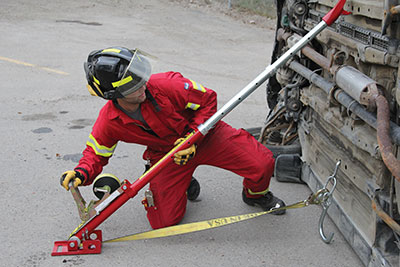 |
|
| The Auto Brace mechanical strut system by HJR Equipment is unique because it can be operated by a single rescuer. Photos by Randy Schmitz |
Command boards
First up is a task-specific command board for motor-vehicle collisions, manufactured by Rescue Innovations/Tactron (www.tactron.com) out of the United States. New technology is changing the way we do business when it comes to MVCs. The incident commander, extrication officer and patient managers each have separate duties to perform. The list of benchmarks to remember can become overwhelming. These boards list the important items that need to be addressed at any taccident. There are three boards in a set, each listing the pertinent information to assist with command roles.
Incident command board
- Benchmarks: dispatch time, 10-minute timer
- Scene safety, patient status (minor, critical, deceased)
- Hazards, resources listed (air lift, heavy wrecker, utilities, hazmat, Department of Transportation)
- Vehicles involved, traffic control, lighting required, responding units
- Layout area of roadway/intersection; on the opposite side of the board is a Velcro tag area for units and assignments with time frames
Extrication officer board
- Scene safety, number of vehicles involved, 360-degree outer circle survey, 360-degree inner circle survey
- Block wheels, patients’ status (minor, critical, deceased)
- Mechanical extrication required?
- Establish extrication plans: rapid, Plan A, Plan B, on which vehicles?
- Undeployed SRS airbag system, stabilization (basic or advanced), interior stabilization, battery disconnection
- Stabilization rechecks, reassessment of plans A and B, clean work area diagram
Patient manager board
- Patient contact, patient status (minor, critical, deceased), level of entrapment
- Best access into the vehicle, rapid extrication, undeployed SRS airbag system, patient updates
- Interior duties, hazard lights, interior extrication considerations
- Opposite side of board: vehicle identification, number of patients and their location within
- Patients: gender, age, vitals, breathing rate, respirations, heart rate, transport, unit, destination hospital
All three command boards have a protective rubber edge and a lanyard. I like the lanyard because it allows the responder to have a free hand. There is also a notes section for adding other information. Permanent markers, dry erase markers or grease pencils can be used on the board. The board is outfitted with a rubber insert for the writing utensil so it won’t get lost. For $66, I highly recommend these boards.
Auto Brace struts
I thought the Auto Brace 2 mechanical strut system by HJR Equipment (www.hjrequipment.com ) was like any other adjustable strut system, until I started using it.
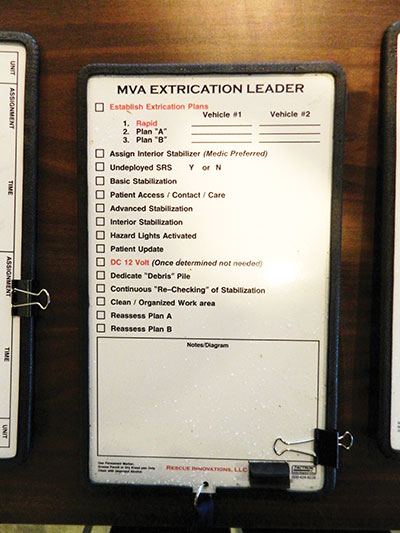 |
|
| Task-specific command boards list the important items that need to be addressed at any type of accident scene.
|
This system can be used as a one-person operation. It can be carried from the truck to the scene and set up by one rescuer. It is comparatively lightweight, which is great for situations in which there is limited manpower. I like the portability – the system features an easy-to-grip handle and the rescuer can carry two struts at one time relatively easily by using a carrying bracket.
Once you are ready to set up the struts, there is an adjustment that allows the strut to stand free until you deploy the ratchet straps, which are permanently attached and deploy easily. You can connect the two hooks on the straps together and tighten them with a handle crank. This locks the strut head connection in place. Typical set-up times are comparable to those of most other strut systems on the market, but the Auto Brace 2 requires less manpower. (See photo page 32.)
All of the struts have finely machined metal components with high tolerances that make tasks such as changing out strut heads easy. Lock pins for the adjustable sections are attached with flexible yet tough wire so they cannot be dropped and lost in snow or mud.
The Auto Brace 2 comes in two sizes: the 2-S stored length is 82 centimetres (32 inches), extends to 150 centimetres (59 inches), and weighs 10 kilograms (22 pounds). The 2-L stored length is 120 centimetres (47 inches) and fully extends to 236 centimetres (93 inches). It weighs 12 kilograms (26.5 pounds). The device costs between $1,950 and $3,700.
Typical set-up time for one firefighter is about 90 seconds. Both the long and short struts are rated to 907 kilograms (2,000 pounds) with a three-to-one safety factor at any length. The Brace 2 has a patented rewind system for the 8.2-metre (27-foot) ratchet straps. The rewind system is built onto the struts for quick and easy deployment.
The RAT
Built by Infinity Bridge Inc. (www.therattool.com), the rescue access tool, or RAT, weighs 7.7 kilograms (17 pounds), so this tool has a lot of leverage to get the job done.
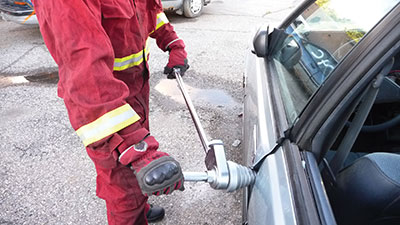 |
|
| The rescue access tool, or RAT, acts as a mechanical spreader designed for small spaces.
|
The RAT acts as a mechanical spreader designed to be placed with accuracy into margins as small as eight millimetres (0.3 inches) where standard extrication tools may not fit. The concept is to expose hinges and Nader pins, and to displace sheet metal to gain access for traditional extrication tools.
By inserting the hardened tip, called the stinger, into the space between a door edge and the vehicle body, this piece of equipment can make short work to gain valuable purchase points. There is no need for a backup power supply, as the RAT is operated on mechanical advantage and hand power. The stinger is inserted into a narrow opening and is rocked back and forth to widen the area. If there is no pre-made margin for the stinger, it can be used to pierce sheet metal to create an opening. Once the purchase point is made, insert the screw tip on the opposite end of the tool and crank its handle to engage the screwing action to further enlarge the hole.
Other uses for the RAT are being studied, for instance, breaking hardened steel locks.
The RAT is listed for $995 USD on the company’s website.
Comfort vest
Heat stress is the body’s reaction to the environment. This occurs when the body’s core temperature rises above safe limits, and can result in a racing heartbeat, profuse sweating, dizziness, reduced energy and slowed reaction times. This reaction reduces safety, decreases efficiency and lowers productivity.
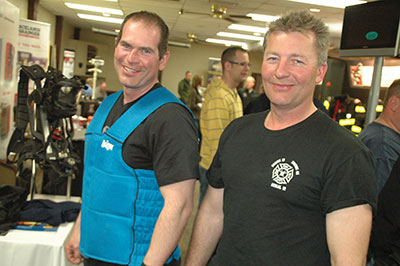 |
|
| Drager’s comfort vest can be worn under protective clothing, and helps to maintain cooler core temperatures.
|
During periods of heavy exercise, the body can generate 10 to 15 times the amount of heat that it does at rest. Extra heat is transferred from the body’s core to the skin, where it is released via sweat and evaporation. High humidity reduces the body’s ability to cool through evaporation and contributes to dehydration. The Drager comfort vest (www.draeger.ca) helps to maintain cooler core temperatures and reduce the severity of symptoms often caused by heat.
The vest can be worn under protective clothing. The vest, which costs around $400, claims to reduce the wearer’s body temperature by three to four degrees. I wore this vest in 27 C weather during an extrication training session and still felt the cooling effects after two-and-a-half hours.
The vest uses a salt-crystal mixture cooling packet, which contains sodium sulphate decahydrate. A benefit of this system is that you don’t have to put this vest in a freezer to return the cooling packets to effective temperatures. An ambient temperature of 22 C prompts a phase change in the packets and they solidify. Simply lay the vest flat and in 30 minutes to two hours, it’s ready for use.
To get the maximum cooling effect, the vest should fit snugly around the wearer’s body. The vest weighs just 2.3 kilograms, and ranges in size from small to five-XL.
Rescue Snips
An Australian firefighter friend of mine, Gerald Van Rongen, told me about the Rescue Snips (www.rescuesnips.com).
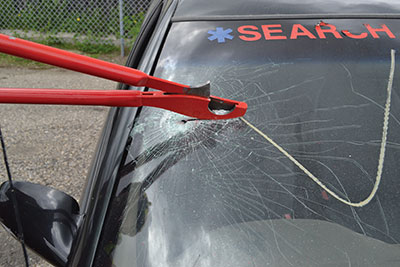 |
|
| While the hand-operated Rescue Snips do not replace a rescue air chisel, the tool is great for departments with limited budgets and minimal compartment space.
|
If you have followed my column, you know I’m not a fan of cutting glass for obvious reasons, namely the fine glass particles that are created from most cutting tools that may find their way into the lungs of emergency responders and patients. I simply choose other methods. However, I do realize there are times when the best course of action is to cut the glass; in this case, the tool I prefer is the Rescue Snips.
The fact that this tool looks and acts like a tree pruner is no indication of its performance. I tried this tool on a standard windshield and found that the Snips created only a limited amount of dust and the dust didn’t fly around as it does with other types of glass cutters; the particles simply dropped straight down onto the dash. The tool also was great for cutting plastic trim and seatbelts, and was useful on single layers of sheet metal. This hand-operated device does not replace a rescue air chisel, but for its portability, size, weight and user friendliness, it is a great tool for departments with a limited budget and minimal compartment space.
HydraFusion strut kit
One phrase sums up my opinion of the HydraFusion strut kit: game changer.
I tested the HydraFusion struts at the 2013 Big Rig H.O.T.S. program in Nisku, Alta., in June. Paratech (www.paratech.com) has been a regular supporter and sponsor of our event since it began in 2009. In the lifting pit where I was instructing, we had a loaded bulk hauler trailer on its side, crushing a pickup truck. The objective was to lift the trailer off the truck to create enough space to carefully pull the truck out of the collapse zone, then extricate the patients. The initial lift was successfully completed with two 18-tonne (20-ton) lift bags, which were supporting three 6-by-6 timbers stacked together. Lift-an-inch, crib-an-inch protocols were followed, and crib stack platforms were used to block up areas for support. The lift was very successful, but this method can take time.
The same group then performed with the HydraFusion struts. Load ratings were calculated and regular long-shore Paratech struts were in place to support the load. The rams are operated by a hydraulic hand pump for smooth operation and give the operator good control with each pump of the handle. With two rams opposing each other at a 60- to 80-degree angle, the two operators brought the load up evenly as they pumped in unison under the extrication officer’s command. With a nine-tonne (10-ton) lift capacity per strut and a 40.5-centimetre (16-inch) lift height, the load was brought up to a sufficient height for removal of the pick-up truck in less than half the time it took to perform the same actins using the lift bags.
I found the load to be more stable using the struts than using the lift bags. Also, setting up the rams requires far less the space than is required for the lift bags. The rams come in three different lift ranges: 10 centimetres (four inches), 25.4 centimetres (10 inches) and 40.6 centimetres (16 inches).
The two-speed, 10,000-psi, single-action HydraFusion pump comes with a three-metre (10-foot) kink-resistant hose and gauge, and weighs five kilograms (11 pounds). I particularly like are the fact that the adjustable carrying strap that can be placed anywhere on the strut. The large pump control knob to manage load descent is also a good feature, and the handle itself has the ability to be locked off in case of accidental release. The kit comes with a five-year warranty against manufacture defects and workmanship. Again, prices vary depending on the kit.
Randy Schmitz is a Calgary firefighter who has been extensively involved in the extrication field for 19 years. He can be reached at rwschmitz@shaw.ca. Follow him on Twitter at @firedog7
Print this page